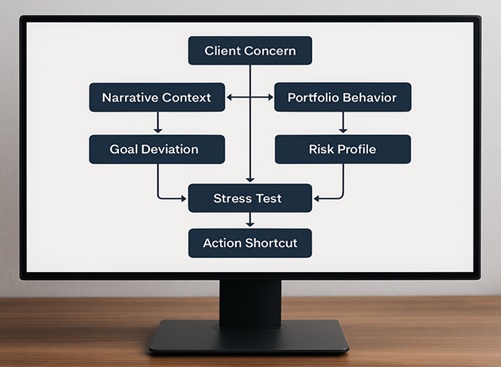
Most dashboards in the wealth management space are built from the database upward: starting with asset classes, positions, returns, and risk figures. This logic is understandable from a system architecture standpoint—but it rarely matches the actual mental pathways of the investment advisor. Advisors don't make decisions based on fields; they reason through patterns, concerns, and objectives. They often begin with a client story, a concern about drawdown, or a market narrative—not a pivot table. When systems impose rigid, segmented layouts, they interrupt these cognitive flows and reduce the clarity of judgment.
A dashboard that looks sophisticated in structure may still be dissonant in practice. Advisors need to move between return attribution, client risk, and investment rationale in a fluid way. Systems that box these components into discrete sections hinder real-world decision-making. It’s not about having more widgets—it’s about whether the layout aligns with the user's cognitive process. Without that alignment, even the most data-rich dashboards fall short.
This disconnect often leads to over-reliance on spreadsheets or side notes, reintroducing manual steps that platforms were meant to eliminate. The root of the problem isn’t missing functionality—it’s missing empathy for how advisors actually think. True digital enablement must start with modeling human reasoning, not database schemas.
An advisor doesn’t wake up thinking about standard deviations or Sharpe ratios. The day often begins with a call from a client concerned about market volatility, or a meeting to review underperformance relative to goals. The thought process is narrative-driven: "Why is this happening? Should we adjust anything? What would the client think?" The system, therefore, must facilitate—not hinder—this diagnostic path.
A typical mental flow might move from the client’s concern to recent portfolio behavior, to deviation from model allocation, and finally to a stress test or forward-looking scenario. None of these steps are cleanly separable. They are interwoven. Advisors move laterally between explanations and diagnostics, not hierarchically between modules.
Dashboards that assume linear navigation (overview → positions → transactions → reports) can’t support this looped reasoning. The best systems are those that allow the advisor to shift direction instantly: from a data point to its narrative context, from performance to regulatory constraints, or from a flagged alert to the source decision. This is how advisors actually work—and what most interfaces fail to support.
A data schema is technical. A mental model is cognitive. Dashboards that prioritize the former become repositories; those that prioritize the latter become instruments. The key difference lies in how information is grouped and accessed. Advisors think in clusters: client, goal, risk, market condition—not in isolated fields. This means platforms must create a bridge between data points and decision points.
One approach is contextual layering. Rather than presenting tabs, systems can offer dynamic context panels—showing related rationale, past commentary, or model deviation alongside current values. Another technique is temporal orientation: organizing data not by asset type but by client interaction timelines, recent changes, or narrative bookmarks. These aren't design flourishes—they are cognitive aids.
Instead of requiring advisors to adjust to the software’s logic, the platform should adapt to the logic of advice. The payoff is not only better usability but also clearer thinking and faster reaction times—without losing nuance.
Too many dashboards confuse visual density with utility. More numbers, more panels, more toggles. But this overload doesn't empower—it paralyzes. A cognitively aligned interface reduces the number of steps needed to answer the question the advisor is actually asking. That question may be simple: "Are we still aligned with the client’s target outcome?" But answering it in many platforms takes four clicks and a report export.
Advisors don’t need more data. They need faster insight. This means highlighting variance, signaling cause-effect relationships, and collapsing repetitive actions. The principle is simple: reduce what the user has to remember or infer. Good dashboards don't just show—they think along.
Design that supports clarity supports better behavior. It reduces reactionary trades, prevents oversight, and encourages holistic client conversations. Platforms that help advisors stay focused are platforms that elevate the quality of the advice itself.
Pivolt doesn’t treat navigation as a menu—it treats it as a reflection of the advisor’s workflow. Drill-downs, lateral jumps, and multi-view toggles aren’t gimmicks—they’re embedded in the platform because they match how decisions actually unfold. Advisors can move from client risk profile to recent deviations, then pivot to model simulations and compliance overlays—without leaving the dashboard context.
This fluidity supports the way high-performing advisors work. It respects the judgment-driven nature of wealth management. It reduces reliance on memory or side tools. And it builds a better interface not by guessing at what data matters—but by understanding how it’s used.
In Pivolt, dashboards are not endpoints. They are launchpads—for insight, for storytelling, for decisions. That’s how software becomes invisible and value becomes visible.
As platforms evolve, the differentiator won’t be more integrations or prettier charts. It will be alignment: with cognition, with judgment, with how advisors actually think. Dashboards must evolve from being passive views to becoming intelligent companions. That means knowing not only what’s being asked—but why.
Wealth management is not a spreadsheet problem. It’s a thinking problem. And systems must be designed to enhance that thinking, not rewire it. The best technology disappears behind the clarity it offers.
In this landscape, Pivolt leads by designing around the advisor, not around the database. And that may be the most intelligent interface of all.